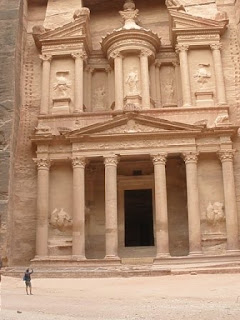In their last paper, I had assigned the class to write about the threats posed to Emirati national identity by the forces of globalization which have made themselves so powerfully and pervasively felt in the UAE over the past two decades. For instance, in the three federal universities all classes with the exception of Arabic and Islamic studies are taught in English. Consequently, it is not uncommon for our students to graduate with a greater mastery of English than Arabic. This is a reason for concern among many Emiratis and has become a bit of a controversial issue here with the Ministry of Education emphasizing the importance of learning English to prepare Emiratis to compete in the global marketplace and the Federal National Council (basically, the UAE parliament) countering that Arabic must receive greater attention in order to preserve national identity in the midst of so many foreign influences (as a reminder, the total Emirati population constitutes only 20 percent of all those living in the UAE).
Another example of the sway of globalization: the quintessential UAE experience, a place which is frequented more than any other by locals and foreigners of all socio-economic backgrounds, is the mall. That's right! Leave it to Gap, Versace, and IKEA to bring people together in a way they otherwise would never have experienced.

Marina Mall, Abu Dhabi
Before assigning the paper on the effects of globalization, we read and discussed several articles on the subject while in class together. As I led the discussion, I tried to empathize with my students who find their way of life increasingly marginalized by foreign ideas and products. I tried to place myself in their shoes so that perhaps I could, in some small way, understand the emotional and psychological toll taken by this constant barrage of all things Western.
But, as I found out after the fact from this one particularly honest student, our class discussion had been inauthentic. In reality, my students do not see things as I assumed they would see them. In fact, when tasked with writing about the potential threats to Emirati identity posed by globalization, most of them had no idea what to write because they simply did not view it in this way, or at least not nearly to the extent I had imagined. When probed they just parroted back to me what they heard me say in lecture and what had been implied in the readings.
Upon reflection, this should come as no surprise for at least two reasons. First, globalization has exposed many in the Middle East to a more egalitarian view of the sexes which has led to the greater empowerment of women. Now, this statement should not be viewed as supporting a sort of "clash of civilizations" mentality where the “West = female emancipation” while the “Middle East = female oppression”; it's more complicated than that. For one thing the UAE Constitution, created in 1971, stipulates that women and men enjoy the same legal status, claim to titles, and access to education. Moreover, women have the right to practice the profession of their choice. Until more recently, cultural strongholds have often prevented most women from laying claim to these rights; however, this is changing, and it is undeniable that globalization has played a significant role in this transformation by showing Emiratis that women around the world are doctors, engineers, CEOs, and government leaders. Keeping this in mind, it makes sense that a young Emirati woman would see globalization not as an enemy but an ally.
The second reason is simple: they're just kids. It takes maturity to realize and acknowledge the importance of one’s cultural heritage and to be critical of pressures to change. While they may continue to embrace globalization as adults, one day (hopefully) they'll have a greater sense of its dangers as well as its benefits and be able to make informed choices regarding the future of this country. For now I just have to figure out how to get them to speak their minds.













